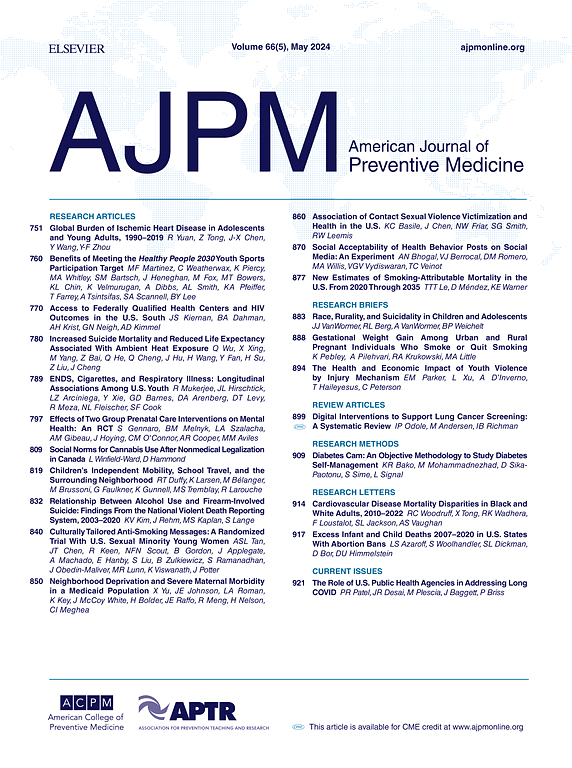健康干预的社会决定因素的成本效益:评估多部门社区合作伙伴的努力。
IF 4.3
2区 医学
Q1 MEDICINE, GENERAL & INTERNAL
引用次数: 0
摘要
导言:这项分析的目的是快速评估多部门社区伙伴关系(MCPs)通过解决健康的社会决定因素(SDOH)来改善慢性病治疗效果和促进健康公平的潜在成本、成本效益和长期效果:2022 年,评估人员与 13 个 MCP 合作,收集有关实施 SDOH 干预措施的启动和持续成本以及干预措施的覆盖范围和时间的数据。2023 年,评估小组利用预防影响模拟模型(PRISM)估算了多边协商进程在 5 年、10 年和 20 年期间所做努力的长期影响。研究小组还分析了多中心 SDOH 干预措施的成本以及 10 年和 20 年的累积成本效益:结果:在 20 年的时间里,13 个多边协商进程实施的 SDOH 干预措施有可能防止 970 人过早死亡,避免 1.05 亿美元的医疗成本和 4.08 亿美元的生产力损失。20 年的累积结果显示,从医疗保健部门的角度来看,每获得一个质量调整生命年的潜在净成本为 38 300 美元,从社会角度来看,可能会降低成本并改善健康状况:这些发现有助于为今后投资 SDOH 干预措施提供信息和支持。通过更好地了解启动和实施 SDOH 干预措施所需的成本,资助者和多边协商进程可以为开展这项工作所需的资源做好准备。研究结果还表明,大多数由多边协商进程实施的 SDOH 干预措施具有良好的长期影响和潜在的成本效益。本文章由计算机程序翻译,如有差异,请以英文原文为准。
Cost-Effectiveness of Social Determinants of Health Interventions: Evaluating Multisector Community Partnerships’ Efforts
Introduction
The purpose of this analysis was to rapidly evaluate the potential costs, cost-effectiveness, and long-term effects of efforts by multisector community partnerships (MCPs) to improve chronic disease outcomes and advance health equity by addressing social determinants of health (SDOH).
Methods
In 2022, the evaluators partnered with 13 MCPs to collect data on start-up and ongoing costs for implementing SDOH interventions and on intervention reach and timing. In 2023, the team used the Prevention Impacts Simulation Model to estimate the longer-term impact of MCPs’ efforts over 5-, 10-, and 20-year periods. The team also analyzed costs and cumulative 10- and 20-year cost-effectiveness of the MCPs’ SDOH interventions.
Results
Over 20 years, SDOH interventions implemented by the 13 MCPs can potentially prevent 970 premature deaths and avert $105 million in medical costs and $408 million in productivity losses. The 20-year cumulative results show potential net costs of $38,300 per quality-adjusted life-year gained from the healthcare sector perspective and indicate potentially reduced costs and improved health outcomes from the societal perspective.
Conclusions
These findings can help inform and provide support for future investments in SDOH interventions. With a better understanding of costs needed to start up and implement SDOH interventions, funders, and MCPs can prepare for the resources required to do this work. Findings also suggest promising long-term impacts and potential cost-effectiveness for most MCP-implemented SDOH interventions.
求助全文
通过发布文献求助,成功后即可免费获取论文全文。
去求助
来源期刊

American Journal of Preventive Medicine
医学-公共卫生、环境卫生与职业卫生
CiteScore
8.60
自引率
1.80%
发文量
395
审稿时长
32 days
期刊介绍:
The American Journal of Preventive Medicine is the official journal of the American College of Preventive Medicine and the Association for Prevention Teaching and Research. It publishes articles in the areas of prevention research, teaching, practice and policy. Original research is published on interventions aimed at the prevention of chronic and acute disease and the promotion of individual and community health.
Of particular emphasis are papers that address the primary and secondary prevention of important clinical, behavioral and public health issues such as injury and violence, infectious disease, women''s health, smoking, sedentary behaviors and physical activity, nutrition, diabetes, obesity, and substance use disorders. Papers also address educational initiatives aimed at improving the ability of health professionals to provide effective clinical prevention and public health services. Papers on health services research pertinent to prevention and public health are also published. The journal also publishes official policy statements from the two co-sponsoring organizations, review articles, media reviews, and editorials. Finally, the journal periodically publishes supplements and special theme issues devoted to areas of current interest to the prevention community.
 求助内容:
求助内容: 应助结果提醒方式:
应助结果提醒方式:


